Juniper Cossack: description, varieties, planting and care
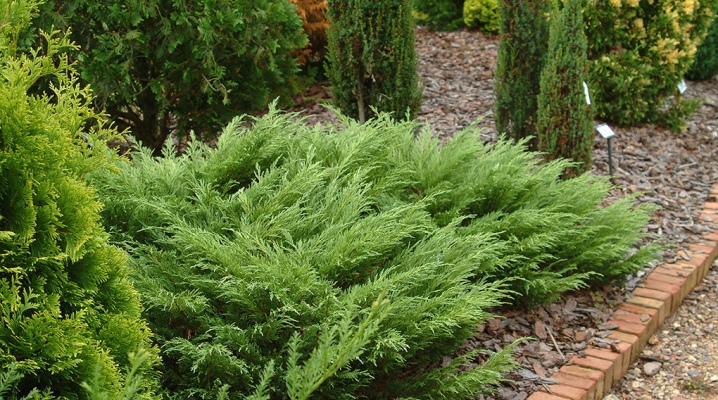
In a wide variety of garden-type conifers, junipers of various sizes are very popular. According to biologists and flower growers, the most popular specimen is the Cossack (Cossack) juniper, and all thanks to the unpretentiousness of the plant, versatility and ease of cultivation. In simple terms, Cossack juniper - one of the most hardy and undemanding types of coniferous plantings... They adapt very quickly to a new environment and value human care. It may seem that the Cossack juniper does not require much attention to itself, as if it is enough just to transplant it into a new land, and it will grow on its own. In general, this reasoning is rational, but it is erroneous.
Correct lighting, timely pruning and appropriate care are very important for Cossack juniper.
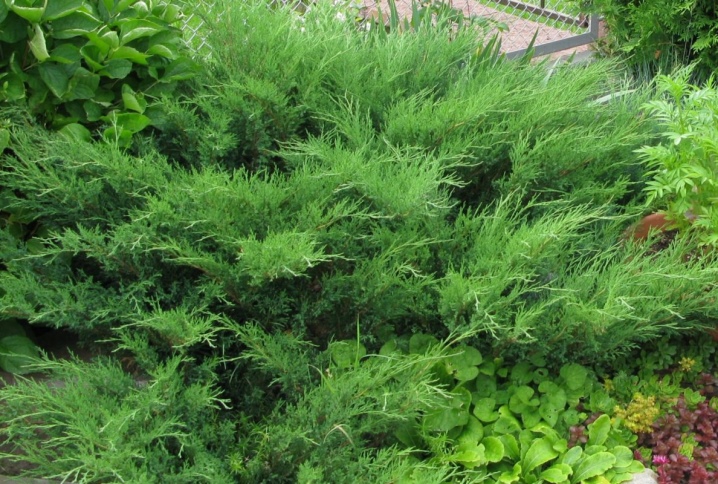
Description
In the wild, Cossack juniper can be found in any part of the Eurasian continent. The amazing flexibility of the character of the plant allows it to adapt to a wide variety of natural conditions, for example, in the southern mountains of Europe or in Siberia. This type of juniper is widespread in the lands of Asia Minor and the Caucasus.
According to biological data, Cossack juniper, or as it is also called juniperus sabina in Latin, is a creeping dioecious plant species... Its dimensions generally increase in width, which results in a rather fluffy coniferous shrub. The root system is strong, easily adaptable to any soil composition.
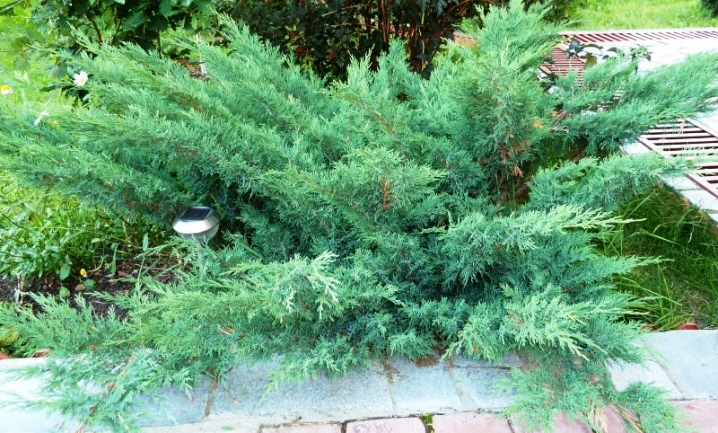
In the wild, there are specimens of this plant growing in the most unusual arboreal forms with a curved trunk. You can endlessly look at this uniqueness of a natural phenomenon.
Even photographers professionally engaged in nature photography appreciate its unusual curves and are ready to spend more than one hour on a photo session of the bush.
The annual growth of the Cossack juniper averages 5-7 cm in length. This factor is important to consider when buying young seedlings. And thanks to its ability to create dense thickets from a number of growing bushes, it will be possible to use coniferous Cossack juniper as an imitation of wildlife in a home garden or create decorative fences. The maximum height of the shrub reaches 4 m.
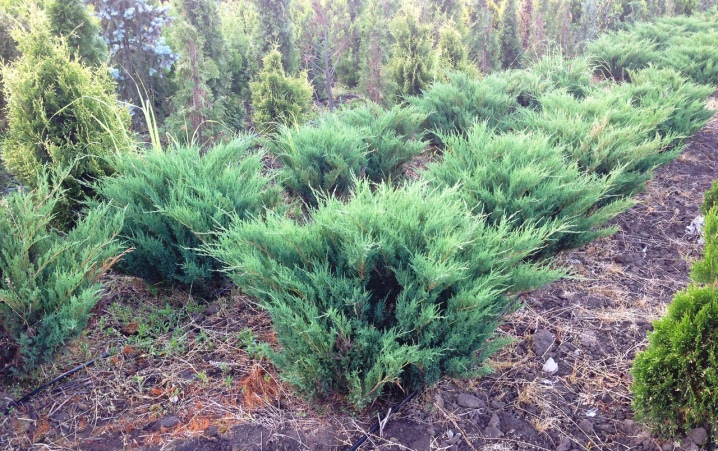
It is worth noting that each element of the structure of the Cossack juniper is considered special, and even the bark. It has a natural brown color, reminiscent of the trunk of a large tree. During the growth of the juniper, uneven flaking of pieces of bark occurs, where subsequently a reddish tint occurs. Very bright brown spots are visible on the branches of old coniferous bushes, which gives the juniper a pronounced picturesqueness and originality. Novice gardeners should know that the Cossack juniper is divided into 2 coniferous species.
- Young look. Above the central vein, softened processes of needles with a bluish scale and blunt tips grow.
- Adult look. In appearance, the needles resemble a kind of dark green scales, and in some places an olive shade is visible.
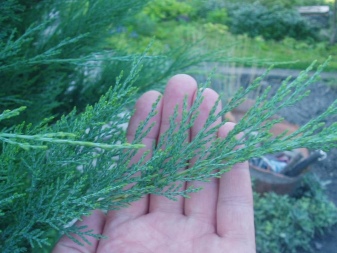
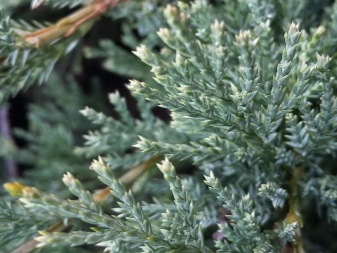
As for the fruits of the Cossack juniper, they cannot be called outstanding. The cones grow very small.Their maximum length reaches 0.5 mm. The shape of the fruit is elongated, the color is blackish, there is a bluish bloom on the surface of the cones. Due to their small size, they easily hide in the needles, and it is almost impossible to distinguish them with the naked eye on dense juniper branches.
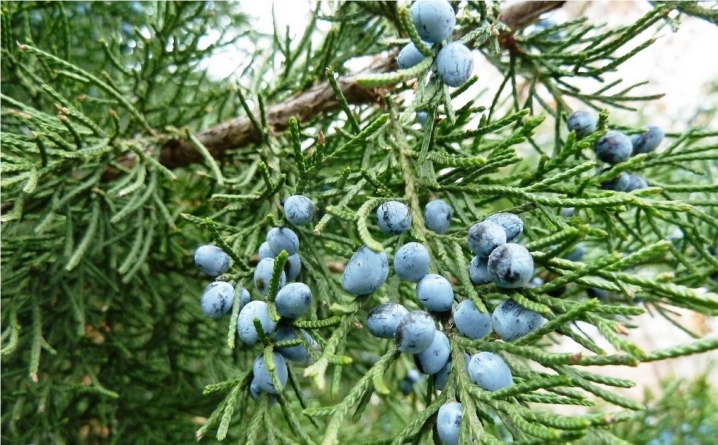
Seeds in cones ripen by the end of autumn or spring of the next year. But the fertile period in the described species of conifers begins only with the onset of 8 years. Among the many coniferous representatives, the Cossack juniper is determined by its smell. It is impossible to confuse such a sharp aroma with other smells. It arises in the process of rubbing coniferous branches with shoots in the hands. In particular, the unpleasant smell is caused by the essential oil, which determines the natural origin of the bush.
The Cossack juniper belongs to the group of poisonous plants, which means that when decorating a home garden, you should not plant it in the reach of four-legged friends and small children.

Popular varieties
The modern garden plant industry is ready to boast of a variety of forms and varieties of Cossack juniper. Moreover, all its types are divided into 3 groups, namely:
- dwarf, their height reaches 50 cm;
- medium-sized with a maximum length of 2 m;
- high, the height of which reaches 4 m.
In general, the Cossack juniper has more than 50 varieties. At the same time, new specimens of the dwarf type are quite often found on the market, since gardeners are actively engaged in their breeding. First of all, we offer you to get acquainted with the most popular varieties of the dwarf type of Cossack juniper.
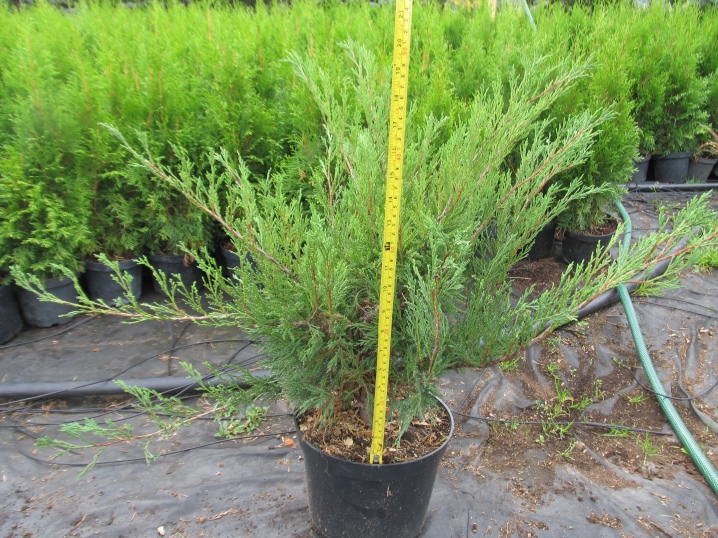
"Arcadia"
Its maximum height is 50 cm, and the striking spreading of the branches can take up a garden space with a diameter of 2 m. According to its characteristics, the Arcadia variety is one of the most hardy varieties. Its needles have a small scale-like shape of a light green hue, which contrasts perfectly against the background of other types of conifers. In the process of growth, the branches of "Arcadia" look upwards, due to which the effect of the density of the bush is enhanced and a feeling of splendor is created. The presented variety of the variety has a positive attitude towards pruning and cutting, which gives the bush a special shape.
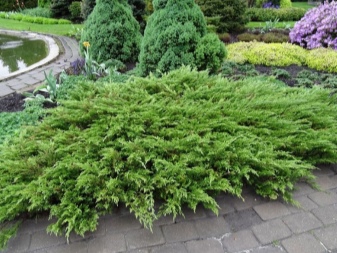
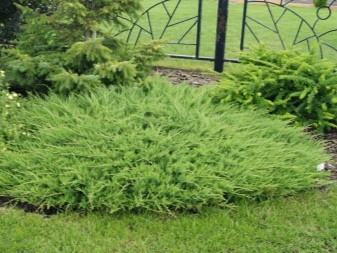
"Variegata"
The shape of the variety presented is decorative. The bush grows dense and compact. The maximum plant height does not exceed 1 m, the diameter reaches 1.5 m. "Variegata" grows slowly. The branches of the plant are laid out almost on the surface of the soil composition, forming a funnel due to the bizarre bends of the tips of the shoots. The bark of plants is whitish, covered with bright scales. In this case, the branches of the bush itself are partially painted in light yellow tones, due to which the plant receives the effect of variegation. Against the background of ordinary green junipers, "Variegata" looks lighter, more elegant and sophisticated, and most importantly, it stands out against the general background of the home garden.
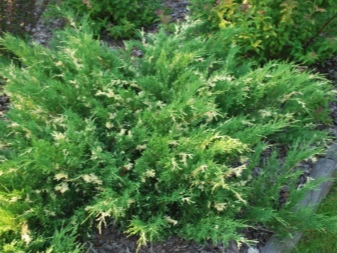
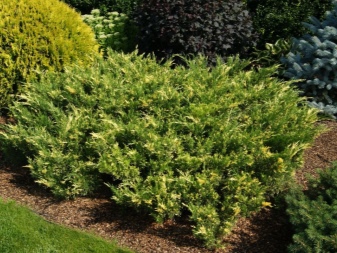
Rockery Jam
This variety is the most powerful dwarf plant among the wide variety of Cossack juniper. Due to the ease of rooting in the soil layer, the coniferous bush constantly grows. With a maximum height of 50 cm, it easily captures an area of 2 square meters. m. The branches of "Rockery Jam" are distinguished by a curly shape. The dark green shoots give the plant an elegant appearance.
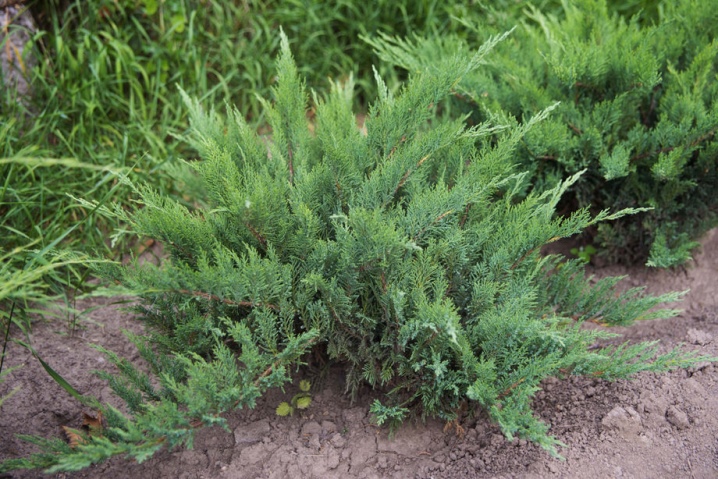
"Glauka"
Another interesting variety from a huge number of varieties of dwarf Cossack juniper. Its distinctive feature is long graceful branches that can occupy a garden area of 3 m in diameter.The height of the bush will not exceed 1 m. Along with her fellows, Glauka is very fond of a lighted residence and drainage in the soil. An important advantage of the appearance is the bronze shade of the needles, thanks to which the bush acquires a special piquancy, corresponding to the winter landscape of the garden.
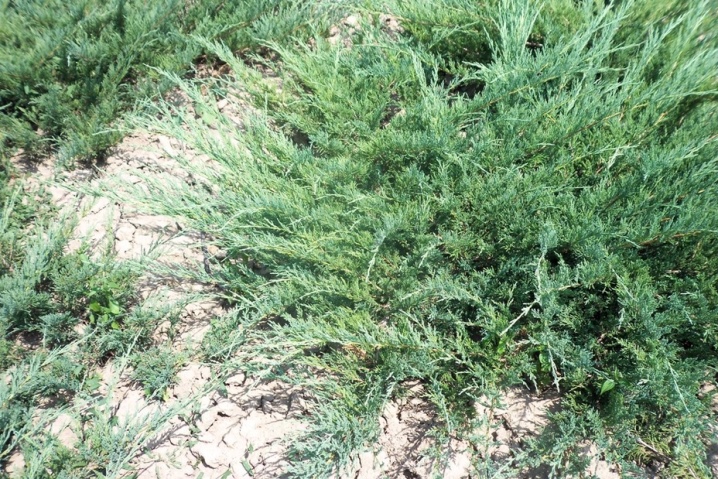
Blue danube
The presented variety of the variety belongs to the dwarf type, although its maximum height can reach 1 m. The plant itself is distinguished by the rapid growth of spreading branches. For a year, the diameter of the bush increases by 20 cm. At the same time, having reached the maximum height, the annual growth of branches does not stop. The needles of the Blue Danube variety are very soft, have a scaly shape of a bluish color. The plant is ideal for outdoor planting in a shaded area. Blue Danube does not accept dry air and requires constant moisture. The first few years of life for the winter, the plant must be covered.
From the information provided, it becomes clear that it is the dwarf varieties of Cossack juniper that are very popular among gardeners... Along with them, the owners of large garden plots are considering options for medium-sized and tall bushes. For example, in the list of medium-sized plants, the 2 most popular varieties are highlighted.
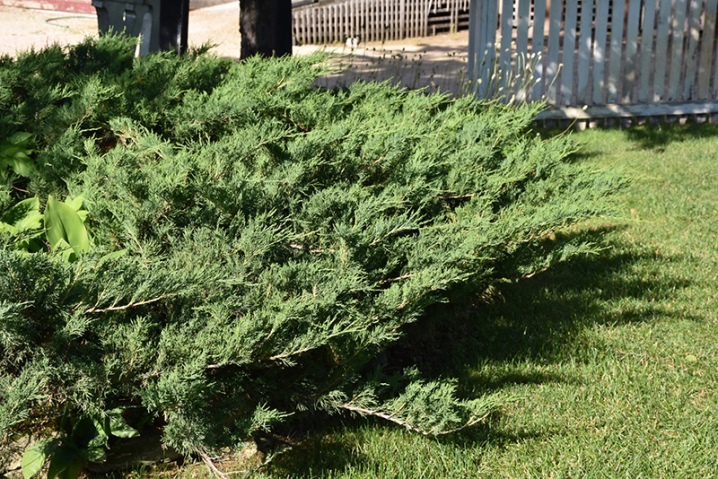
"Mac"
The presented variety of the variety is distinguished by its special beauty and grace. Despite the fact that the maximum growth of the bush is 2 m, in the process of growing the plant becomes massive, its diameter ranges from 5 to 7 m.The branches can boast of wide spreading and beauty of the pattern, reddish bark and needle-like needles. The growth process is not fast. The maximum increase in the diameter of the bush per year does not exceed 20 cm. Despite this fact, this variety belongs to one of the most durable plants.
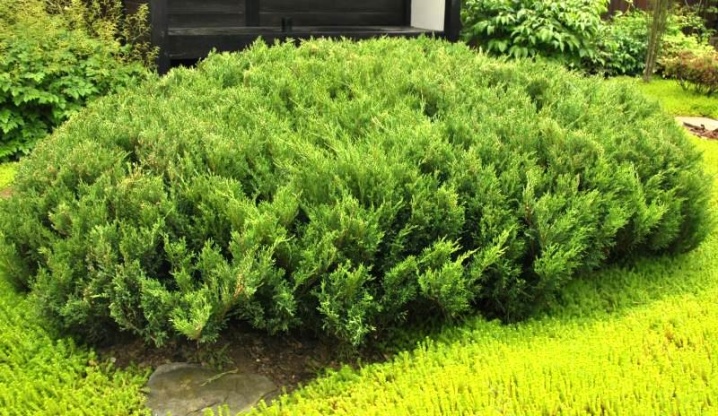
Femina
This variety is the female representative of the Cossack juniper. Its spreading branches are rather large, which is why the shrub takes on a powerful shape. The maximum plant height is 1.5 m. The diameter can exceed 3 m. The bark is highlighted with a gray-red tint. Unfortunately, Femina cannot boast of an excellent pleasant aroma, therefore it grows in a home garden in splendid isolation.
Of the low varieties of Cossack juniper, only one plant species is of particular interest to gardeners, namely Erecta. From the point of view of gardeners, the largest and most massive planting is one that grows at an angle of 45 degrees, which creates a diagonal effect. The color of the bush is dark, close to a swampy green shade. When decorating landscaping, it is best to use the Erecta variety, coupled with powerful stones, for example, to make an alpine slide.
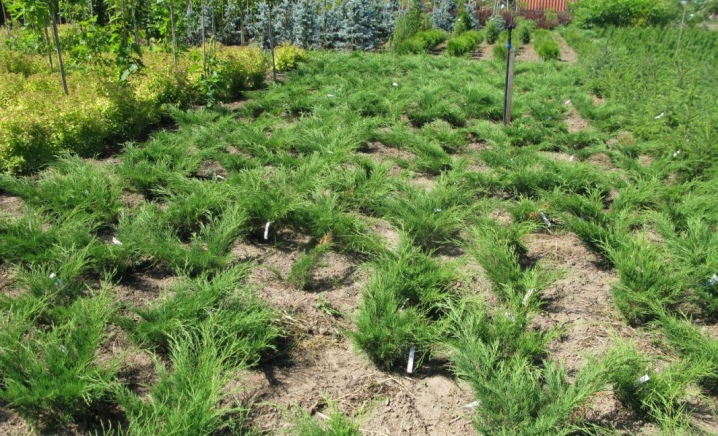
Boarding and transfer rules
A favorable time for planting Cossack juniper is the spring period, when the plant has not yet entered the phase of active growth. If it was not possible to plant in the spring, you can postpone the procedure to the autumn period, maximum - until the end of September. As for a seedling with a closed root system, planting is allowed from the onset of spring to autumn.
For a cold climate, it is advisable to plant in the spring, so the seedling will be able to take root and prepare for the winter cold.
Planting technology is similar to all brothers of the Cossack variety of juniper. Initially, a large planting pit is prepared in the open ground, so that its dimensions are 2 or even 3 times the rhizome. Drainage is laid out at the bottom. The bush is placed in such a way that the root collar is not buried, but remains open. After that, a substrate is added to the pit, the soil is slightly compacted, then a hole is created around the seedling for irrigation.
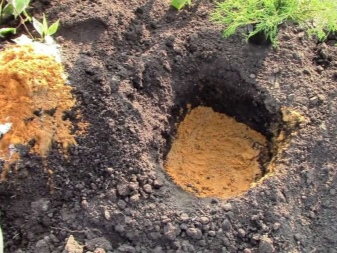
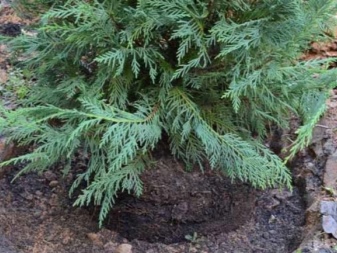
Novice gardeners who decide to decorate the area with Cossack juniper should know that the distance between the bushes should be less than 50 cm. Planting them next to each other, at a distance of even 30 cm from each other, would be a gross mistake. The last stage of planting is abundant watering. But to transplant Cossack juniper to another place is not an easy task.
The plant is difficult to perceive the process of moving.For this reason, it is initially necessary to choose a new place of residence for the plant.
Be sure to observe the orientation relative to the cardinal points. Approximately 5-6 months before the day of transplanting, it is necessary to make soil punctures along the perimeter of the crown. The extreme branches can be used as a guide. Transferring a plant to a new place of residence must be done with a whole earthy lump.so that the rhizome is not damaged. And after transplanting, the gardener needs to mentally prepare for the thorough care of the bush. It will need to be sprayed often, to carry out prophylaxis with various substances.
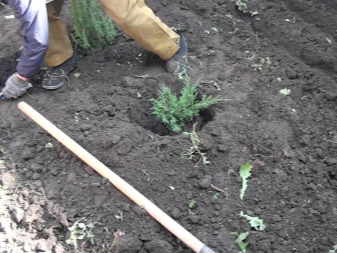
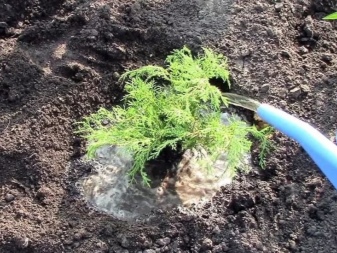
Care
The Cossack juniper is an unpretentious plant, but, like other plantings, it loves to feel the care that lies in proper care. And it's not just about standard feeding, watering and processing. There are other procedures that the Cossack juniper cannot do without:
- removal of damaged and dried shoots;
- loosening the soil composition;
- weeding and cultivation.
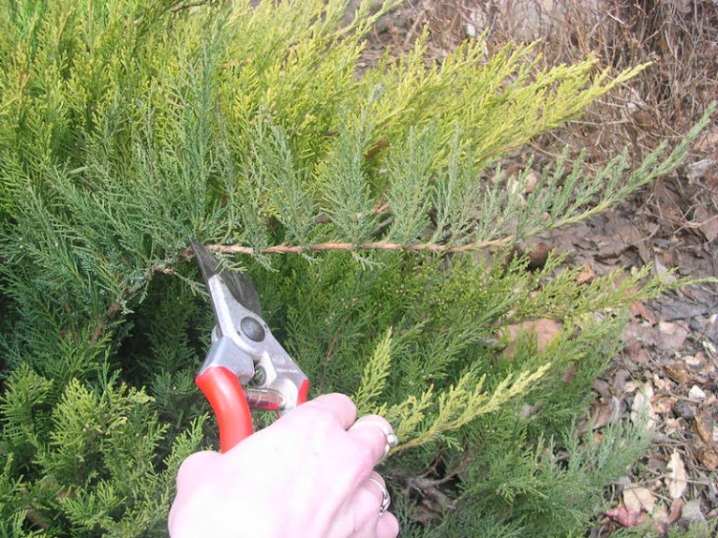
A haircut
The procedure for pruning and shearing of Cossack juniper is done at different times of the year. Sanitary processing is a prerequisite and necessary condition for each variety of Cossack juniper and is done exclusively in the spring. You only need to cut off burnt branches, if any, on the bush, as well as unnecessary shoots growing in an undesirable place, for example, crawling out onto the path.

Cut off areas of plants heal very quickly, and all thanks to the high level of resins that appear with the arrival of spring. The trimming procedure for shaping the plant can be done during the warm season, in spring and summer. And in order to maintain the conceived design, the bush should be corrected every month.
Watering
The Cossack juniper is an unpretentious creation of nature, and first of all it concerns the irrigation procedure. Bushes only need to drink in hot climates. At the same time, sufficient watering consists in pouring only 3 full buckets of water under the root once a month. Although young bushes should be watered a little more often, do not forget to loosen the soil near them and get rid of growing weeds.
Juniper Cossack reacts positively to spraying the crown before sunset.

Top dressing
The process of feeding Cossack juniper is more complicated than watering. Young bushes should be fed in early spring with solutions of superphosphate and nitroammophoska in a ratio of 30 g of composition per 1 sq. m, as well as a mixture of low concentration, suitable for all conifers. It is strictly forbidden to feed the juniper with any kind of industrial fertilizers.eg manure or formulations with high nitrogen levels. The elements present in them negatively affect the root system of the plant, lead to burns, due to which the deformation of the crown occurs. After the young seedling reaches three years of age, you can reduce the complementary food. After all, the well-known phrase "it is better to underfeed than overfeed" is directly related to the Cossack juniper.

Reproduction
Like most other plants, the Cossack juniper lends itself to reproduction, and now every amateur can create a coniferous greenhouse or make a decorative fence of the garden area. Thanks to the hard work of gardeners and biologists, 4 breeding options for Cossack juniper are known today, each of which has its own characteristics and involves certain requirements for the procedure.
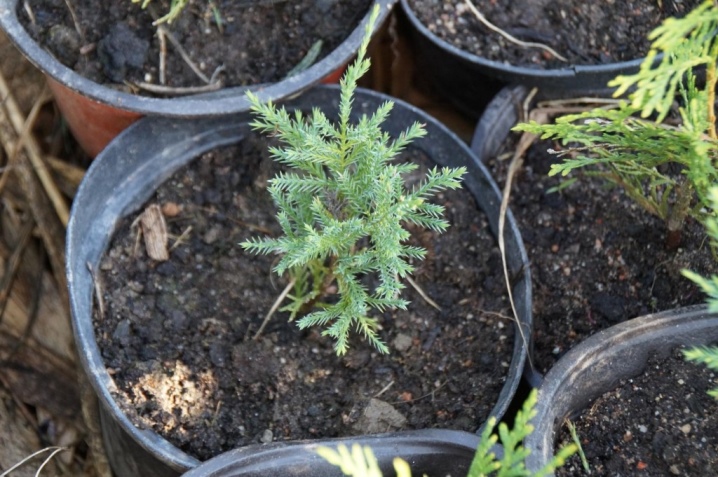
Cuttings
A fairly common and most common way of propagating various types of plants. In this case, you can use both a shoot plucked in the wild, and a small shoot from a bush growing in the garden. Cuttings can be of the winter-autumn type, as well as spring and summer. A small stem is cut from the base of an adult bush and placed in fertile soil. In the spring or summer period of the year, abundant watering is carried out until the gardener is confident that the cutting has taken root.
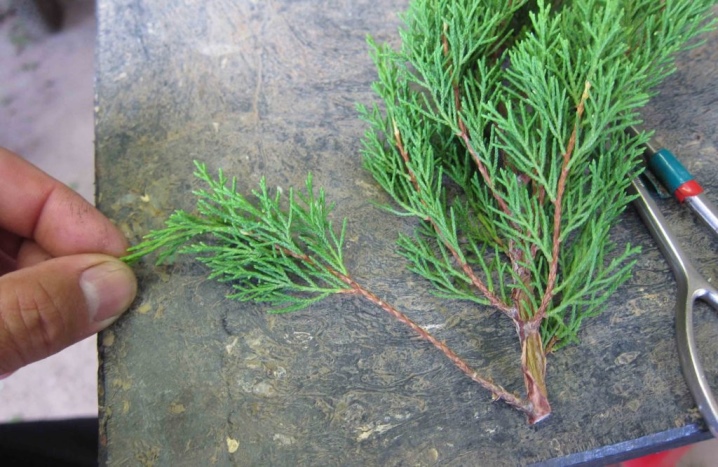
In the winter-autumn period, it is necessary to maintain a moist soil until the first snow appears. It will be possible to start watering in the spring, after the snow has melted. If the planting takes place before the onset of cold weather, it is necessary to cut off the stem of the plant and push it into the soil by about 15 cm.
The main thing is that the soil is not frozen.

Seeds
Modern gardeners try not to use the seed method of reproduction of the Cossack juniper. Firstly, because the process is very long, the work itself is extremely laborious. Secondly, in the final result, a juniper grows, which has lost its grade.
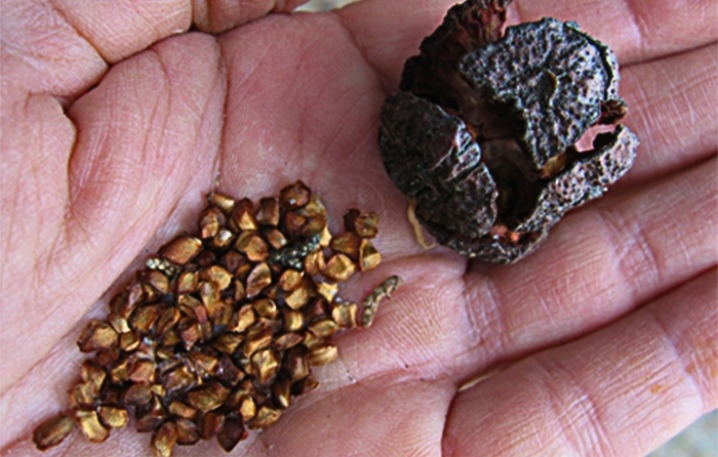
Layers
The easiest way to increase the population of Cossack juniper on your own site. We are talking about the rooting of branches in contact with the soil surface. The same factor contributes to the growth of the bush in width, due to which dense thickets are formed. If the soil rooting is not visible, it is enough to cut off the necessary material from the parent bush, root it and plant it a short distance. It is much easier to lean and pin the branch to the ground, and then water it periodically.
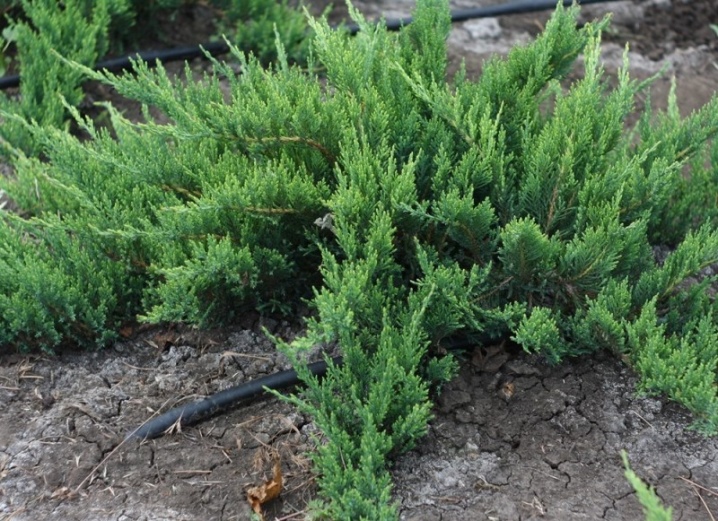
Vaccinations
This method of reproduction will help to obtain an ornamental plant in a short period of time. To do this, you need to combine 3 or 4 pieces of material at once. The main thing is that during rooting, they are located at an angle of 45 degrees, forming a bowl shape. The only caveat is the lack of cup-like shape in some juniper varieties; you should not take them for grafting propagation.
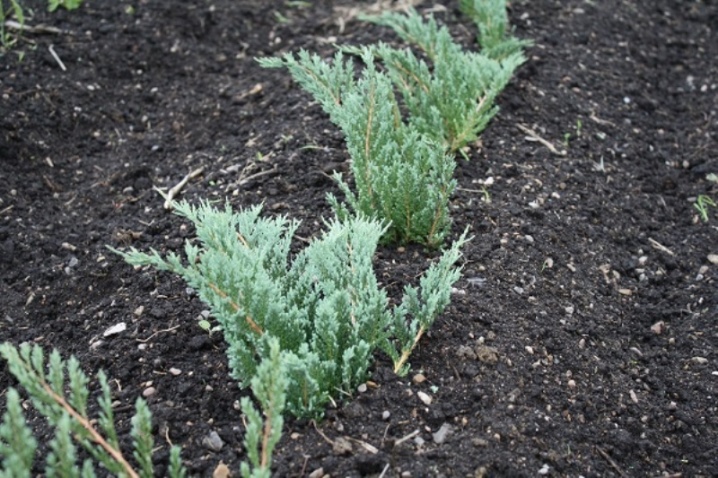
Diseases and their treatment
Due to the poisonous characteristics of the juniper, pests rarely disturb this plant. Moreover, they are afraid not only of poison, but also of the unpleasant smell of a coniferous representative. During its youth, the bush can be attacked by ticks, aphids and scale insects. However, to combat them, a plant with an insecticide or Fitoverm is enough.
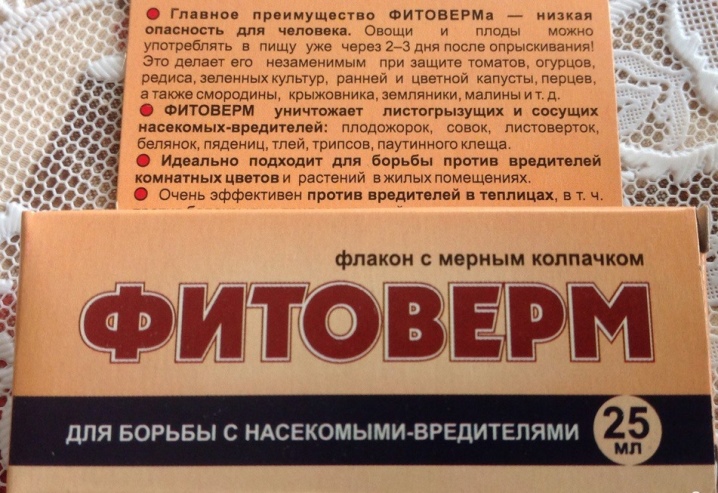
The gardener must take the issue of juniper diseases extremely seriously. Young bushes quite often suffer from the burns of the spring sun. Othe main signs of the disease are the yellowness of the crown and shedding of the needles. To avoid such an unpleasant situation, it is recommended to cover the bushes with spruce branches at the end of February.
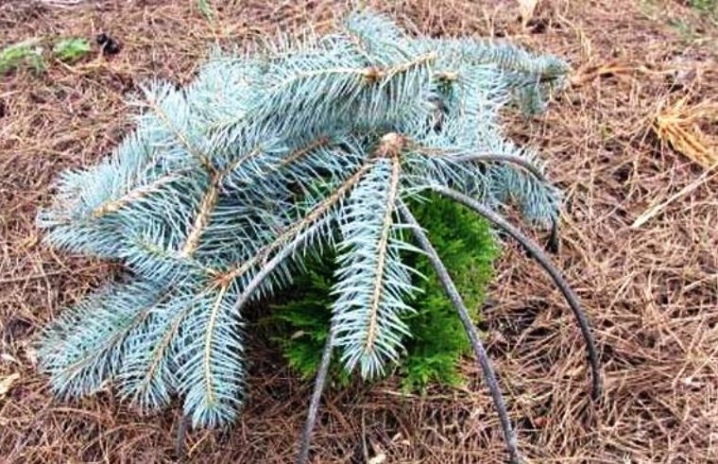
Fungal infections are a serious danger for the Cossack juniper. For this reason, it is strictly forbidden to plant coniferous bushes near rosaceous plantings, namely pears, apple trees, mountain ash. These trees are susceptible to fungal diseases, which multiply by spores and are carried through the air by gusts of wind, respectively, can affect plantings growing nearby. The first sign of a fungal infection is the appearance of growths on the branches, a change in their shape and subsequent death. If suddenly at least one sign of the disease appears on the juniper, it is urgent to cut off the affected area and burn it. The bush itself should be sprayed with a fungicide solution.

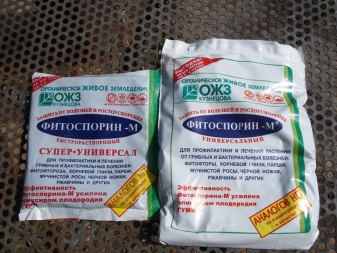
Another serious disease that can be contracted by juniper is biotorella cancer. The main signs are the appearance of growths on the bark, the bush itself turns yellow, and the needles fall off. The cause of this disease is mechanical damage through which fungi penetrate into the plantation. In the fight against the disease, a 1 percent solution of copper sulfate helps. In this case, diseased branches are cut off, and the places of the cuts are processed with garden varnish.
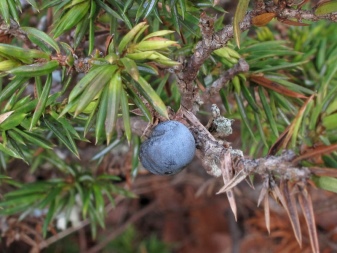
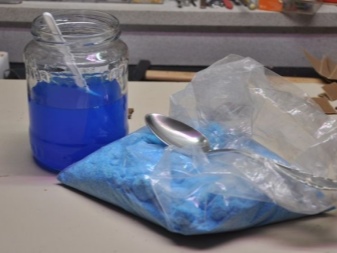
One more an unpleasant disease that affects the root system of the Cossack juniper is fusarium... The infection enters the plant through contaminated soil.First, the root system of the bush is affected, after which the feeding process is disrupted, the color of the needles changes, the tops of the shoots begin to turn red, then the branches dry up and the bush dies. If this disease occurs, it is necessary to spray the soil under the plant and the entire bush completely with "Fitosporin" or "Fundazol". The affected areas are cut and burned.
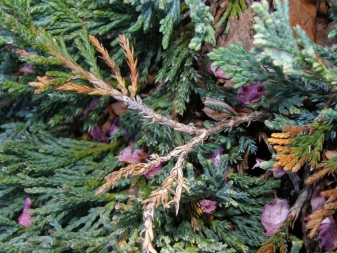

Application in landscape design
The Cossack juniper is considered the most suitable variety of conifers to protect the soil and create beauty in the garden. With its help, it turns out to decorate any object, for example, a staircase or decorate an entrance group to a garden. In this case, it is not so important whether the surface will be flat or inclined.
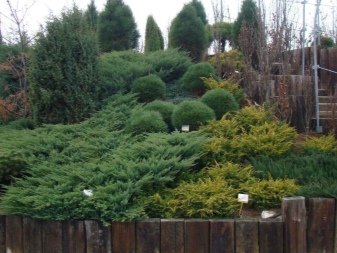
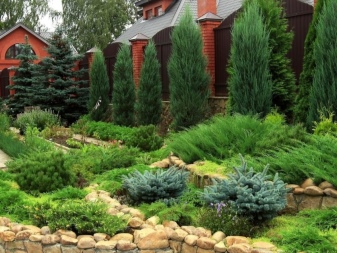
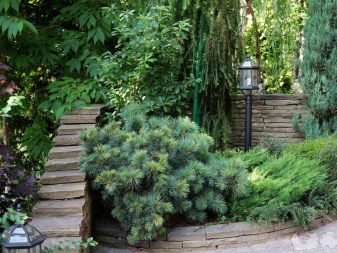
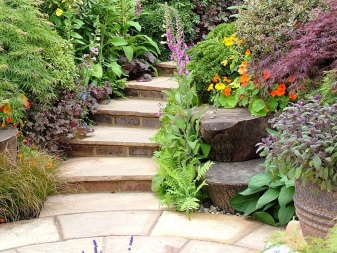
Landscape designers very often use Cossack juniper in the design of alpine slides, due to which the difference of different heights is emphasized and played out, the multi-level effect is enhanced and continuous coverings are masked. Basically, Cossack juniper looks good both in a single version and in group plantings... The coniferous representative can be grown next to evergreens or in the company of deciduous bushes and trees, which looks most impressive.
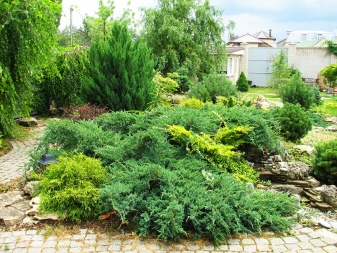
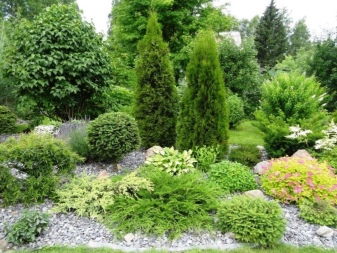
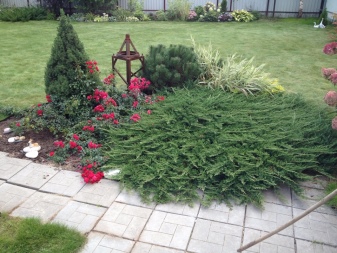
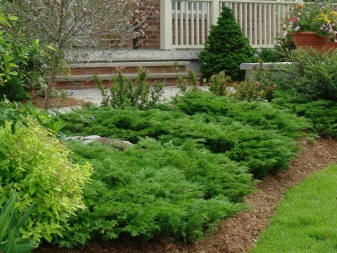
From the point of view of landscape design, there are no stylistic restrictions on the use of Cossack juniper. It is good both in a natural setting and in a different form. Most often, Cossack juniper is used to design certain zones of the garden plot, thereby pursuing the goals conceived by the designer. GIn simple words, in the art of correctly creating a landscape, coniferous plantings are used to decorate and frame several elements of a blooming territory.
- Dwarf seedlings are used to transform the curb line.
- For adding variety to flower beds. When designing artificial reservoirs.
- As an artificial hedge for front gardens.
- To decorate the edge of the garden area.
- As an alternative to ground covers in continuous areas and in massifs.
- As decorative elements of small architectural structures.
- High varieties of juniper are used to decorate the further part of the general plan of the ornamental garden.
- The spreading branches of the bush can serve as an ideal decoration for the surface of a mown lawn.
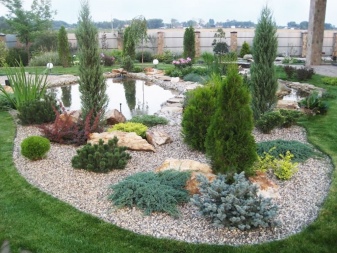
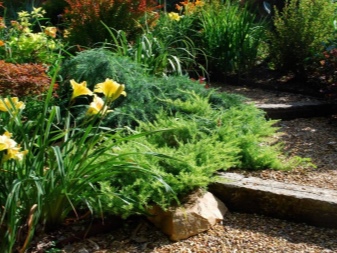
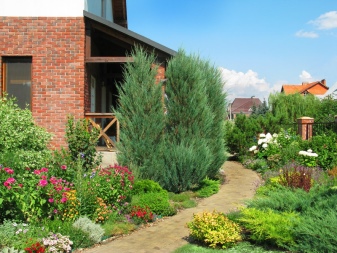
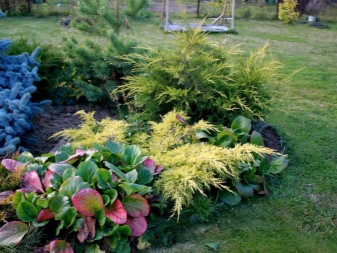
It is important to remember that Cossack juniper is one of the best representatives of phytoncidal plant species. It has health-improving properties, purifies the surrounding air, and improves the ecology of a particular area. As already mentioned, the juniper easily tolerates the procedure of cutting and cutting, which is what landscape designers use when decorating garden plots.
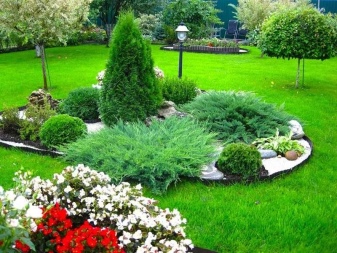
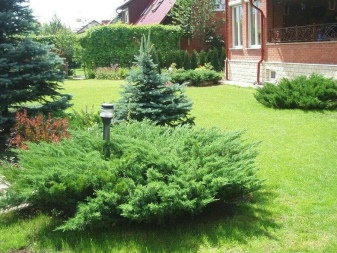
They use niwaki, the art of shearing plants, to give coniferous bushes a graceful shape that matches the idea of a landscape designer. Wherein nivaki are mainly used in large areas of garden plots, where you can turn around and turn ordinary plantings into a piece of paradise... In gardens with a small area, juniper bushes are only slightly pruned so that branches do not crawl out onto the path and do not interfere with the growth of other plants.
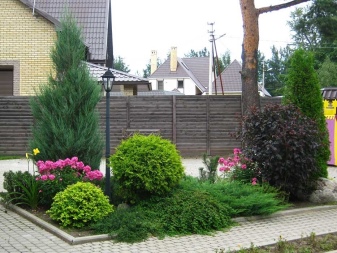

For information on how to propagate and care for the Cossack juniper, see the next video.



































































The comment was sent successfully.